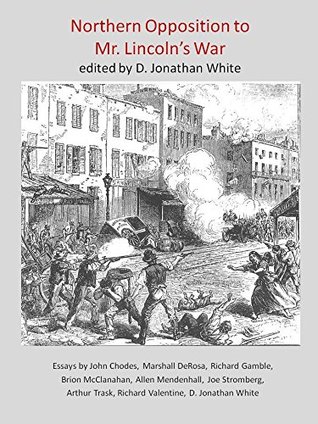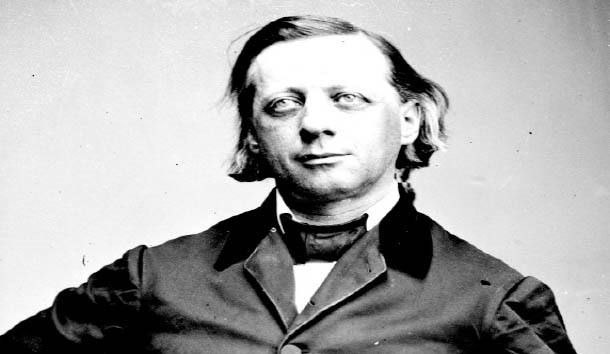A minority on the left is possibly willing to admit that a few “good Southerners” during the War Between the States opposed slavery, secession, and the Confederacy. Probably a much smaller minority would concede that a considerable number of Northerners opposed the war either to preserve the Union or to free the slaves. That, in early 21st-century America, is simply too much reality to bear by people who seem to imagine that, for four long years, hundreds of spontaneous Two Minute Hates and abuse of the Confederate Battle Flag occurred daily across the 15 states remaining in the Union, and that so many fervent Northern abolitionists volunteered for army service that Lincoln was compelled to scrap the draft and establish a lottery system allowing everyone an equal chance at holy martyrdom.
Northern Opposition demonstrates otherwise. It shows also that the Founding Fathers’ view of the United States as a federal system of sovereign states established for the welfare of those states, not the benefit of the system itself—which was also the majority view, South and North, right down to 1861—was robustly maintained throughout the war by a significant, and vocal, segment of the Northern population.
The excited patriotism that followed the Confederate attack on Ft. Sumter began to wane fairly quickly, and the casualty figures for the summer and fall of 1862, added to the Emancipation Proclamation (which seemed to replace the restoration of the Union with the abolition of the Peculiar Institution as President Lincoln’s principal war aim) and economic disruption in the Northwest, provoked significant popular opposition to the war that led to a loss of congressional seats and state legislatures, and of governorships, by the GOP in that year’s fall elections.
The Copperheads, reviled by Republicans then and now as traitors, were simply Northern Democrats who believed in “The Union as it was, the Constitution as it is.” Their understanding of the Constitution was the traditional one, on which Jefferson Davis took his stand. Lincoln, by contrast, questioned what he called
the particular sacredness of a State. . . . If a State, in one instance, and a county in another, should be equal in extent of territory, and equal in the number of people, wherein is that State any better than the county?
(Of course, the Constitution nowhere offers grounds for discrimination among the states of the Union in geographical area or any other category, save in representation; while, according to the Maestro’s logic, the state of Texas should outweigh in political influence all of the Northeastern states, and then some.) D. Jonathan White, in his introductory essay, reduces “the central dilemma” of the Civil War to the fact that “Americans loved their country but Americans also approved of self-government.”
The nine articles in this volume, the first fruit of the Abbeville Institute Press, are all excellent, ranging from a vindication of Franklin Pierce’s understanding of the Constitution (Marshall DeRosa), through an informative discussion of the Copperheads (Professor White); the bloody fanaticism of the Northern clergy (Joe Stromberg); Oliver Wendell Holmes’s ambivalence regarding Lincoln and the war to save the Union (Allen Mendenhall); Lincoln’s oppression of Maryland to prevent her secession (Brion McClanahan); the schism in the Presbyterian Church produced by the war (Richard M. Gamble); the conflict between Yankees and New Yorkers over Lincoln’s bellicosity (R.T. Valentine); and the tyrannical behavior of Indiana’s war governor (John Chodes), down to an account of the resistance by the Philadelphia aristocracy to the President’s war policy (Arthur Trask). While every contribution is excellent and informative, to my mind the most memorable are Trask’s “Philadelphia Against the War” (also the best written of them) and Stromberg’s “Blood on the Pulpit: Northern Clergymen, the Kingdom of God on Earth, and the Abolition of the South.”
Trask’s “Philadelphia” is a surprising thing. Pennsylvania, he explains, became first more Whig, then more Republican, as it industrialized, “but it never became anti-slavery or antisouthern.” Whatever animosity existed in Philadelphia before the war was toward New England and its self-righteous and covetous spirit.
Philadelphia blamed [New Englanders] for the war. They did not blame slavery or southerners. In the words of a prominent Philadelphia Democrat, “the same spirit of persecution, which in the history of New England manifested itself from its earliest colonial period, and fastened, from time to time, upon various objects, has for the last twenty-five years been concentrated on the South.”
“Blood on the Pulpit,” on the other hand, is an astonishing revelation of the emotional and spiritual forces at the historical root of a new political conflict shaping up in America today. Here is a Methodist parson (a proslavery Unionist) speaking against President Johnson in 1866:
The second army of invasion will, as they ought to, make the entire South as God found the earth, without form and void. They will not, and ought not, to leave one rebel rail-fence, outhouse, one dwelling, in the eleven seceded States. As for the Rebel population, let them be exterminated. When the second war is wound up, which should be done with swift destruction, let the land be surveyed and sold out to pay expenses.
And here is the Rev. Henry Ward Beecher on constitutional government:
I know it is said President Lincoln is not the Government, and that the Constitution is the Government. What! A sheep-skin parchment a government! President Lincoln and his Cabinet are now the Government, and men have now got to take their choice whether they will go with their Government or against it.
The reverend’s words express the violent self-righteousness of the radical Puritan and New England theological temper, the caesarism latent in liberal democracy. The first has been a formative element in American history since 1620, the second from Abraham Lincoln’s First Inauguration. Both tendencies have waxed and waned since 1865, but today they are resurgent to a degree they have not been in 150 years. A Second American Civil War is the result, an ideological conflict waged (so far) against the South as the immediate target, the historical America as the ultimate one. It begins to appear that, as the Second World War was a resumption of the First after a truce lasting 21 years, so the Second Civil War is a continuation of the First, a century and a half later.

[Northern Opposition to Mr. Lincoln’s War, edited by D. Jonathan White (Waynesboro, VA: Abbeville Institute Press) 295 pp., $15.00]

Leave a Reply